SUV
BMW Brilliance

BMW has always been a favourite standout brand of mine, and BMW is forging new models and technology even as we speak. It has been a bit of a gruelling year-or-two with the covid shenanigans, and car manufactures are only one small segment of the global economic pie to have taken a sizable hit. The shortage of semiconductors has been, and still is, a problem because cars rely on these items for controlling anything from your electric windows to all the fancy driving assistance aids. However, the winds are changing, and the rebound is occurring. Luxury car marques like BMW seem to be doing very well, and even with the electronic chip shortages being a bit of an issue it seems that BMW will get through this period in fairly good shape. There is always a talking point re this special car marque; sometimes the designs might look great to some and not so flash for others, but there is always a gem being turned out from this great team of motoring designers and manufacturers. BMW cars are more often than not great to drive, good looking, practical and advanced cars.
In this covid recovery period, various chief financial officers recently mentioned that, for now, luxury marques like BMW would consciously undersupply demand levels, which seems a prudent, sensible path to take, as BMW new car prices are holding up very well – quite bullish in fact. The increased pricing power has already trickled down to the bottom lines for BMW and Daimler. Mercedes achieved a 12.2% return on sales in the last reported quarter, which was up from 8.4% in the same period in 2018 (2018 being of a period not affected by the pandemic or diesel emissions litigation costs). BMW achieved a 16% return on sales, which was up from 8.6% in 2018. BMW also reported a $5.7 billion net profit in the second quarter of this year, suggesting global auto markets are continuing to recover from the pandemic — particularly when it comes to luxury cars like BMW and Mercedes.
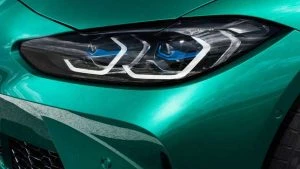
BMW M4 Minty Green
This is great news for BMW and car lovers in general, but what’s new in BMW’s box of tricks? A very cool thing that BMW revealed at the recent Munich Motorshow (early September 2021) was to be found in the BMW M4 corner, where this manic machine, with its impetuous acceleration, showed a jaw-dropping minty green sheen to its beautiful, sexy exterior. The M4 Competition wore a Mint Green paint job and sat upon gorgeous bronze 20-inch rims. Both of these options are available as part of the brand’s expanded BMW Individual customization line, which you can find on BMW’s online configurator, where more than 130 other paint options and eight different wheel options are available. This latest BMW M4 Competition also had a new fibre front splitter, a restyled rear bumper, a rear wing, and some unique side skirts that were all made with carbon fibre. Carbon fibre interior seating surfaces and trim pieces are also part of the online configurator. So, try before you buy!
The Munich motor show also allowed the public to preview a hydrogen-electric BMW X5 that is due to enter very-limited production in 2022. This is an exciting moment because the vehicle was first previewed in 2019 as the i Hydrogen Next concept. It’s currently in the prototype stage, and early this month it was confirmed with the go ahead, going by the name of BMW iX5 Hydrogen.

A hydrogen-electric vehicle is like a battery-electric vehicle, but instead of drawing power from electricity out of the charged battery the hydrogen-electric vehicle relies on a hydrogen fuel-cell stack to produce electricity power. BMW’s iX5 Hydrogen has the hydrogen fuel-cell positioned up front where it draws hydrogen from 2 tanks, one in the X5’s transmission tunnel and another under the rear seats. The tanks are made from carbon-fibre-reinforced-plastic and can hold about 5.9 kg of hydrogen at more than 10,000 psi. Tank filling takes only a few minutes. The hydrogen fuel-cell combines hydrogen with oxygen from the air to create electricity. This process only has water (H2O) as a by-product – Wow! The electricity primarily powers a single motor at the rear axle but is also used to charge a small battery that steps in from time-to-time to deliver extra grunt to the motor during high-load situations.
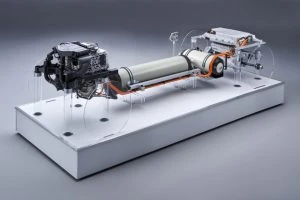
BMW iX5 Hydrogen Platform
The BMW iX5 Hydrogen will have a total system power output of 275 kW. The hydrogen fuel cell, on its own, generates about 125 kW. The vehicle’s aerodynamically shaped 22-inch wheels are wrapped in a new Pirelli tyre that is made from natural rubber and a wood-based synthetic fibre known as rayon. These two materials replace much of the petroleum-based synthetic rubbers used in modern tyres.
The extensive field testing has already started in earnest within Europe. Particular focus points have had the engineers examining how effectively the CO2-free drivetrain works in real-life conditions. Also, they are measuring metrics which include reliability, safety, and efficiency during everyday conditions to ensure that the new model is perfect for mass production. Hydrogen fuel cell technology has the potential to supplement internal combustion engines, plug-in hybrid systems, and battery-electric vehicles. The BMW iX5 Hydrogen has hydrogen tanks that can be filled quickly in only 3–4 minutes.
BMW states that the small batch of iX5 Hydrogen models that are destined to be built in 2022 will only be used for demonstration and testing purposes. BMW doesn’t expect to have any hydrogen-electric vehicles at dealerships until 2025 at the earliest and depending on the direction that the automotive markets take.
Newest off the showroom floor is the all-new BMW iX3 with its refreshed exterior design. The new BMW iX3 has a sexier appearance and introduces the M Sport Package as standard. BMW has achieved an impressive CO2 emission assessment for this next-generation iX3, and the vehicle boasts an exceptionally efficient drive system. Extensive use of secondary raw materials in the manufacture of aluminium castings and thermoplastics combines with the new iX3 boasting an absence of rare earth materials and the use of more green electricity in its production.
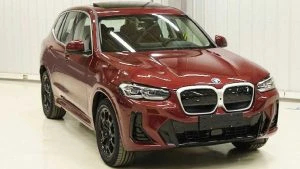
BMW iX3 2022
The BMW iX3 has a kidney grille that is larger still, and it has a single-piece frame that comes in Pearl-effect Chrome with blue accents to match with the BMW i styling cues. Its headlights have been made slimmer. It also boasts 19-inch black aerodynamic wheels, an automatic tailgate, adaptive suspension, a heated steering wheel, a panoramic sunroof, and Smartphone integration with Apple CarPlay and Android Auto.
BMW is a bit of a landmark in the automotive world, a benchmark, the perfect blend of performance, luxury and practicality. In the future, BMW wants to be ready to supply customers with their powertrain of choice, whether it be gasoline, diesel, battery or hydrogen. In the case of hydrogen, BMW sees it as an opportunity for customers that favour long-distance driving or who happen to live in regions without adequate battery recharging infrastructure.
I have so many favourite BMWs and other cars, including the 4.0-litre Falcons, which have rolled our roads over the last few decades of motoring, but let’s not be nincompoops and let’s embrace new ways of automotive power; let’s embrace the new BMW i technology.
New EV SUVs
We still seem to be desiring the SUV over other shapes and styles of car. This is for reasons that I can understand; things like safety, space and ride comfort tend to be found in spades when you travel inside a decent-size SUV. Because we are likely to go through a period of history where the EV may well rule the road, are there any SUV-type EVs available now? EVs aren’t selling like hot cakes just yet, but there some EV SUVs bigger than a pint-sized Honda E that you might be interested in. It turns out that, actually, there are some pretty decent EV SUVs available to the buyer loaded with cash. As yet, they aren’t the cheapest vehicles on the planet, particularly if they are of the premium luxury brands, but it’s nice to know that if you did have the money, and wanted a spacious and desirable luxury model, they are already being sold out on the market.
Tesla has the jump on its competition, and they already have a decent wodge of EV clients under their wings. Because it was pretty much the first EV manufacturer to design and build a decent EV, it was Tesla who soaked up the early adopters of Tesla’s EV technology, and it was these buyers who were very keen to align and embrace the new EV technology early on. What is happening now, is that because other manufacturers are only now getting fully into the swing of EV technology, the keenest buyers have already been wooed and taken by Tesla, so, for instance, if you are an Audi e-tron or Jaguar I-Pace, you have a slightly harder job of getting your buyers because you have to actually entice them away from their luxury ICE vehicles and into one of their EV variants.
Tesla Model X
Let’s first give credit where credit is due, and let’s talk about the Tesla Model X EV SUV. The Model X can come with an optional six seats, the middle row boasting full-on Captain’s chairs. The five-seat Model X is the standard guise. I love the falcon-wing doors; they look so cool and make life very easy getting in and out of the car – even in tight parking spaces with as little as 11-inches on either side. Tesla’s Model X cabin is nice, big, and comfortable. Up the front, there is a big infotainment display screen on the dash. This is as big and as good as it gets in any car. The roof/ceiling is also a huge display screen, which is tinted so that the glare from the sun is minimised. The Tesla feels extremely modern but also, at the same time, quite a simple car that is fun to live with. It has funny features like a Fart Mode, which is an emissions testing mode that allows the car to perform fart sequencing and farting whenever it requires to do so. People outside don’t escape the sounds either. This feature does leave one in hysterics – you have been warned! The Tesla Model X is very different to anything else on the road, and that makes it a unique drive. Out on the road, the Tesla Model X is quick, and its ride does a pretty good job of soaking up the bumps. There are better handling cars like the Audi e-tron and Jaguar I-Pace, however.
- Twin electric motors
- 100kWh battery
- Weight: 2459 kg
- Range: Claimed at over 500 km, real world driving more likely to be around 300 km.
- 310 kW of power
- 660 Nm of torque
- Top speed: 250 km/h
- 0-100 km/h: 4.9 seconds
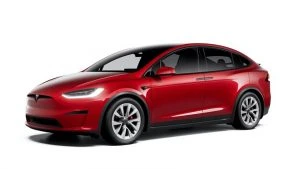
Tesla Model X
Audi e-tron
Audi’s new e-tron has five seats, all rather comfortable and impeccably crafted. The touchscreen system is classy, right up-to-date, and detailed. You do have plenty of menus to work through before finally getting to where you want to be in the infotainment set-up. On the road, the Audi e-tron is exceptionally well-sorted. It feels really tight around the corners, smooth and very quiet. Though EVs are generally heavy vehicles, the e-tron disguises its mass very well, indeed. There is plenty of well thought-out storage compartments throughout the cabin, and on a day-to-day basis this is a nice EV SUV to live with.
- Twin electric motors
- 95kWh battery
- Weight: 2490 kg
- Range: Claimed at around 385 km, real world driving more likely to be around 300 km.
- 300 kW of power
- 664 Nm of torque
- Top speed: 200 km/h
- 0-100 km/h: 5.7 seconds

Audi e-tron
Volvo XC40
Volvo’s XC40 Pure Electric Hybrid is a smaller luxury EV SUV. Safety features include autonomous emergency braking, run-off-road assist and up to Level 2 self-driving in heavy traffic situations. It’s available with AWD and uses a nice silent, smooth electric set-up. The Volvo’s version of an EV SUV is a gem. The XC40 looks and feels very modern, and the XC40’s cabin is impressively spacious. Standard equipment levels are high and include a 12.3-inch digital instrument panel with configurable EV-specific displays, panoramic sunroof, heated front power seats, and inductive charging for your smartphone. Also standard, is the full suite of Volvo safety features, including lane keep assist, blind-spot and cross-traffic alert, and rear collision alert. The 460 litres of boot space opens up to 1336 litres with the rear seats folded down flat. These can be bought new for around $85k, making this a well-priced premium luxury EV SUV that is comfortable and swift.
- Twin electric motors
- 78kWh battery
- Weight: 2158 kg
- Range: Claimed at around 418 km, real world driving more likely to be around 300/350 km.
- 300 kW of power
- 659 Nm of torque
- Top speed: 180 km/h
- 0-100 km/h: 4.7 seconds
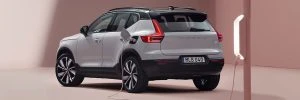
Volvo XC40 Recharge Electric
Jaguar I-Pace
In my opinion, the Jaguar I-Pace wins the EV SUV beauty contest. From every angle it looks nice, athletic, and the perfect blend of old and new design. Even with its GT lines there is a nice amount of space inside the EV Jag. To drive, the Jaguar I-Pace is wonderful. It feels very crisp through the corners and it even has a satisfying growl that flows through the speaker system as you plant your right foot and accelerate hard. Compared with its rivals, the new Jaguar I-Pace weighs in at a comparatively light 2.0 tonnes. This is a lovely EV SUV and is probably the one I’d prefer most of all the snobbish EV SUVs currently on sale.
- Twin electric motors
- 90kWh battery
- Weight: 2068 kg
- Range: Claimed at around 420 km, real world driving more likely to be around 300 km.
- 294 kW of power
- 695 Nm of torque
- Top speed: 200 km/h
- 0-100 km/h: 4.5 seconds
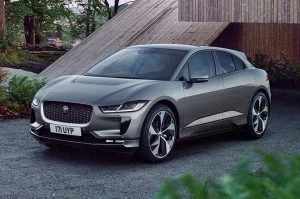
Jaguar I-Pace
BMW’s latest iX and Mercedes Benz’s EQC are some other luxury EV SUVs worth a look at. And then some other considerations that are substantially cheaper than the premium EV SUVs mentioned above would be the small Mercedes-Benz EQA and the very good MG ZS EV, Hyundai Kona and Kia Niro.
Some big reasons why you’d want to change to a EV SUV right now would be the driving smoothness, the driving silence, self-driving safety features, and the potential for saving money at the “pump”. I think it was Top Gear who recently suggested that, on average, the running costs of one of these were on a par with an equivalent petrol car capable of 73 mpg (3.2 litres/100 km). That’s if you were to do most of your charging at home and not at public charging stations.
The 2021 World Car Of The Year Is…
Volkswagen’s ID.4. The electric SUV is the German brand’s fifth WCOTY after: 2013 World Car of the Year – Volkswagen Golf, 2012 World Car of the Year – Volkswagen UP!, 2010 World Car of the Year – Volkswagen Polo, 2009 World Car of the Year – Volkswagen Golf VI.
It’s still unclear as to whether it will make its way to Australia. What will be unavailable is a 77kWh battery, offering a range of up to 520 kilometres. Power is rated as 150kW and torque at 309Nm providing a 0-100kph time of 8.5 seconds. The rear is where the engine is located. Battery charge from a 120kW DC source can provide 320 kilometres of range in a half hour, and the 11kW charger built in can provide 53 kilometres in an hour.

It’s expected that a dual-motor version will be released with power bumped to around 225kW. Chassis wise, it’s a bespoke EV design, and on a length of 4,580mm, it sits neatly between VW’s Tiguan at 4,486mm and the Tiguan Allspace, a seven seater and 4,701mm in length. Crucially, it will offer cargo space of 543L (rear seats up) to 1,575L (seats folded), offset against the Tiguan’s 615L/1,775L and the Allspace’s 230L and 1,655L. Up front is a cargo area of sorts, with the cargo being the 12V battery for the ID.4’s ancilliaries and accessories, plus the various cooling system equipment parts.

ID.4 will be built across three continents and in five factories, highlighting the still “Dieselgate” beleaguered company’s move to a stronger EV presence in a market that is growing worldwide.
Ralf Brandstätter is the CEO of Volkswagen, and he firmly believes in positioning this EV as a mainstream model “with the potential for significant volumes.” Those volumes, he says, are in in Europe, China, and North America. The ID.4 will also “play host” to a range of related brand vehicles from Skoda, Audi, and Cupra.
Future versions of the ID.4 are said to include all-wheel drive and a choice of both batteries and engines. These include a 109kW, 125kW, 129kW or 150kW rear-mounted electric motor with a 52kWh battery the power source for the first two, and a 77kWh battery for the latter. This battery
will also be the source for two all-wheel drive versions, with either 195kW or a mooted GTX packing the 225kW engine.

Kleva Kluger Is A Hefty Hybrid.
Toyota’s near twenty year old Kluger nameplate is joining the Toyota family of Hybrids. The big petrol powered machine, which has never had a diesel option, weighs in at a hefty two thousand kilos (dry) in its forthcoming Hybrid form. It will become the eighth Hybrid for the Japanese company.
The Kluger will come in 2WD or AWD petrol, or AWD Hybrid, and the Hybrid has the Toyota 2.5L petrol, whilst the Kluger stays with the familiar 3.5L V6 capacity in a new engine block. There willbe three trims levels, with the GX 2WD petrol starting from $47,650, the GXL 2WD petrol from $56,850, and Grande 2WD petrol from $68,900. Move to AWD and pricing runs at: GX AWD petrol from $51,650,
GXL AWD petrol from $60,850, and Grande AWD petrol from $72,900. The Hybrid range starts from $54,150 for the GX AWD hybrid, $63,350 for the GXL AWD hybrid, and $75,400 for the Grande AWD hybrid. Premium paint is a $675 option, with the Grande offering a rear seat entertainment system at $1,500. Sean Hanley, the Toyota Australia Vice President Sales and Marketing, said the addition of a hybrid option to one of Australia’s favourite family SUVs demonstrated Toyota’s commitment to driving sustainability forward. “The popularity of SUVs continues to grow and the new Kluger hybrid models mean that families can have all the space, comfort, refinement and versatility of a large SUV with a low environmental impact. In addition to that, the stylish new look, improved safety and high level of advanced technology makes the Kluger the perfect SUV for the modern family.
Sean Hanley, the Toyota Australia Vice President Sales and Marketing, said the addition of a hybrid option to one of Australia’s favourite family SUVs demonstrated Toyota’s commitment to driving sustainability forward. “The popularity of SUVs continues to grow and the new Kluger hybrid models mean that families can have all the space, comfort, refinement and versatility of a large SUV with a low environmental impact. In addition to that, the stylish new look, improved safety and high level of advanced technology makes the Kluger the perfect SUV for the modern family. Power comes from the 2.5L four and a pair of electric motors up front, backed by a single rear mounted engine. Toyota says the Hybrid’s combined power is 184kW, with the petrol engine contributing 142kW itself. Torque isn’t quoted for the Hybrid, however 242Nm is the 2.5L petrol engine’s figure and emissions of 128g/km. Jump to the 3.5L and 218kW is backed by 350Nm with drive being passed through a new eight speed auto.
Power comes from the 2.5L four and a pair of electric motors up front, backed by a single rear mounted engine. Toyota says the Hybrid’s combined power is 184kW, with the petrol engine contributing 142kW itself. Torque isn’t quoted for the Hybrid, however 242Nm is the 2.5L petrol engine’s figure and emissions of 128g/km. Jump to the 3.5L and 218kW is backed by 350Nm with drive being passed through a new eight speed auto.
The Hybrid has an electronic continuously variable transmission (e-CVT). The e-Four AWD system allows up to 100 per cent of drive to be sent through the front wheels or up to 80 per cent through the rear, depending on the conditions being driven in. This Dynamic Torque Control AWD system, which effectively disconnects the rear diff when AWD isn’t required, will be available in the GX and GXL. The Grande also receives a torque vectoring system, splitting torque to left or right as required. There will be three driving modes too, with Eco, Normal, and Sport offering a breadth of choice. Also included in the AWD models is a terrain adjustable program for Rock and Dirt, Mud and Sand soft-roading. Underneath the wheelhouse, the new Kluger is built on an updated chassis, called Toyota New Global Architecture or TNGA platform. The wheelbase is increased by 60mm longer wheelbase as is the overall length. It’s also somewhat broader than the current 2021 model for more interior room and stability on road. The suspension has been redesigned with multilink front and rear setups, with better overall ride quality, better handling, and better behaviour under braking conditions. Bigger discs at 340mm front and 338mm add their presence.
Underneath the wheelhouse, the new Kluger is built on an updated chassis, called Toyota New Global Architecture or TNGA platform. The wheelbase is increased by 60mm longer wheelbase as is the overall length. It’s also somewhat broader than the current 2021 model for more interior room and stability on road. The suspension has been redesigned with multilink front and rear setups, with better overall ride quality, better handling, and better behaviour under braking conditions. Bigger discs at 340mm front and 338mm add their presence.
An exterior revamp sees a lessening of the heavily squared-jaw look, with slim LED headlights and taillights, with the front fenders rolling inwards slightly at the top for a visual weight reduction. There is a new line for the rear wheel arches, with a sinuous curve rolling up from the doors that reminds of the current IndyCar rear structure. Wheels themselves will be 18 inch alloys on the GX and GXL, and bespoke Chromtec 20 inch alloys for the Grande. The increase in space means increased comfort and Toyota adds in sliding and 60/40 split centre row seats, with the seven seater having 60/40 split fold also. Trim material finish has gone up a grade with soft touch dash materials, a higher quality cloth trim in the GX, and faux leather for the GXL. That grade also has gained heated front pews. GX and GXL have an 8.0 inch touchscreen, Android and Apple compatibility with DAB and Bluetooth, plus satnav for the GXL along with tri-zone climate control. Grande adds in a sunroof, HUD, and an 11 speaker audio system from JBL.
The increase in space means increased comfort and Toyota adds in sliding and 60/40 split centre row seats, with the seven seater having 60/40 split fold also. Trim material finish has gone up a grade with soft touch dash materials, a higher quality cloth trim in the GX, and faux leather for the GXL. That grade also has gained heated front pews. GX and GXL have an 8.0 inch touchscreen, Android and Apple compatibility with DAB and Bluetooth, plus satnav for the GXL along with tri-zone climate control. Grande adds in a sunroof, HUD, and an 11 speaker audio system from JBL.
GX has dual zone, auto headlights and rain-sensing wipers as standard. Five USB ports make for family friendly smart usage. The increased wheelbase adds up to increase the cargo and third row space as well. Also upped is safety, with Toyota’s Safety Sense gaining traffic sign recognition, intersection turn assist, and emergency steering assist across the three, backing up the already substantial safety package.
The current expected release date for Australia is June.
